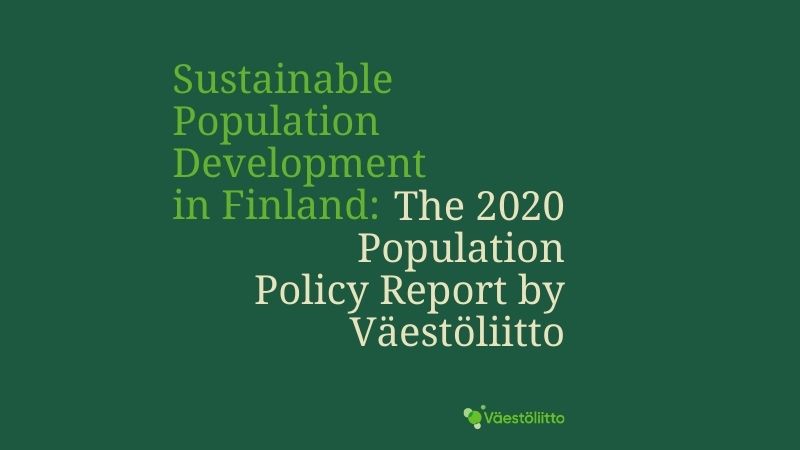Population policies for the 21st century – Finland as a case example

Väestöliitto’s population policy report, Sustainable Population Development in Finland, is now available in English. The report presents ten population policy goals for Finland, such as achieving ecologically sustainable population development and developing ethical and humane incentives to increase immigration and reduce emigration. Finland is among the most rapidly ageing populations in the world, and the Population Policy Report 2020 aims at stimulating international conversation on sustainable population policies of the 21st century.
Post-industrial populations are facing rapid demographic changes. Decreasing birth rates coupled with increasing longevity feed into population ageing that challenges the financial foundations of welfare states, as the shrinking working-age population is responsible for a growing number of financially inactive elderly people. Väestöliitto’s population policy report functions as a case study for ageing European populations, and we hope to spark conversation in support of the European Union initiative “Demographic change in Europe – green paper on ageing”.
Väestöliitto’s report examines current themes and trends in Finland’s demographic change and policies. The topics include birth rates and population development, immigration, internal migration, and health inequalities between social strata. It also considers the impact of demographic change on the pension system and other public finances, ecological sustainability, and subjective well-being. The authors represent the very best expertise in their fields from various organizations in Finland.
In addition to expert views, the report presents Väestöliitto’s take on the population policies Finland should pursue in the 21st century.
“Väestöliitto pursues a population policy that aims at well-being, ecological sustainability, and global responsibility. Everyone should have the right to lead their lives in safe and prosperous relationships”, emphasizes Eija Koivuranta, the Managing Director of Väestöliitto.
According to Väestöliitto, population change should be considered holistically, balancing social sustainability, ecological sustainability, and economic sustainability.
- A suitably sized Finland is not shrinking yet.
- Balanced population development is ecologically sustainable.
- An increasing birth rate in Finland is something to strive toward.
- People need to be supported in having as many children as they wish for.
- Good relationships are at the core of public health.
- Family-friendliness applies to all.
- Immigration should increase significantly.
- Finland is an attractive and humane new home country.
- Multi-locality regenerates regional development.
- Create incentives to reduce emigration.
Demographic change forms the basis for other policies
Väestöliitto’s previous Population Policy Report was issued in 2004. Since then, Finland has changed in many ways: net immigration has tripled, and birth rates have fallen to historically low levels. Population is aging faster than expected.
Active monitoring of population developments is an essential basis for informed decisions in population policies as well as other societal issues. With translating the Population Policy Report in English, Väestöliitto and The Finnish Pension Alliance TELA, aim to launch an open and research-based debate on population policies across Europe.
Demographic trends are also absolutely essential for the financing of pensions. The size, wellbeing and participation of the working population will for their part determine how we secure pensions and the whole welfare state for future generations. Demographic trends can be influenced, and effort must be made to do so. Supporting citizens in achieving their family size goals is a good example, encouraging labour migration is another,” says Janne Pelkonen, Public Advocacy Manager at TELA.
“It is essential that European countries have common challenges. It must also be possible to discuss demographic objectives and adaptation at EU level, even if individual policy measures fall within the jurisdiction of Member States. The next steps following the consultations on the Green Paper should unbiasedly focus on promoting the birth rate and on more active support for national population policies. The discussion launched by the Green Paper completely lacks the perspective of promoting birth rates and the perspective of goals,” Pelkonen states.
More information
Eija Koivuranta, Managing Director
firstname.lastname@vaestoliitto.fi
+358 50 574 1775
Venla Berg, Director of Research
firstname.lastname@vaestoliitto.fi
+358 50 369 6429
Sorsa, Tiia (ed.) Sustainable Population Development in Finland: The 2020 Population Policy Report by Väestöliitto.